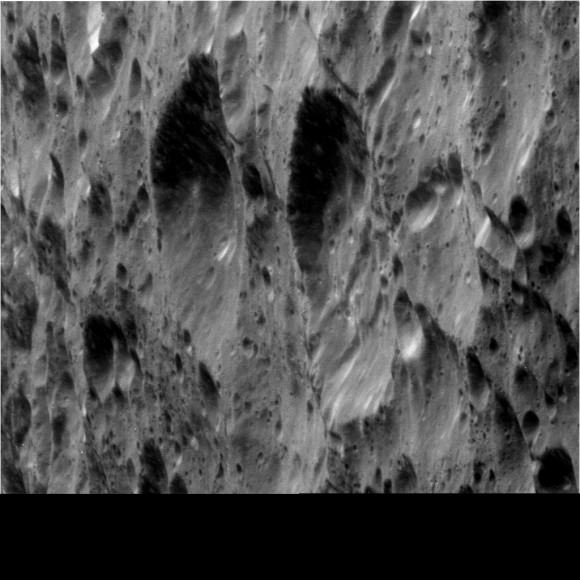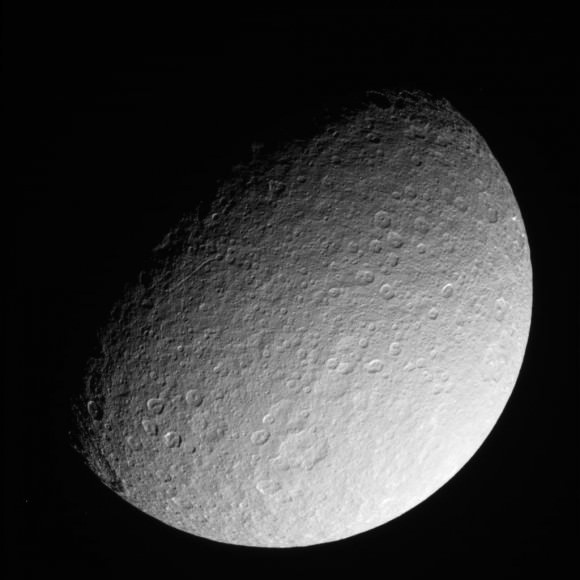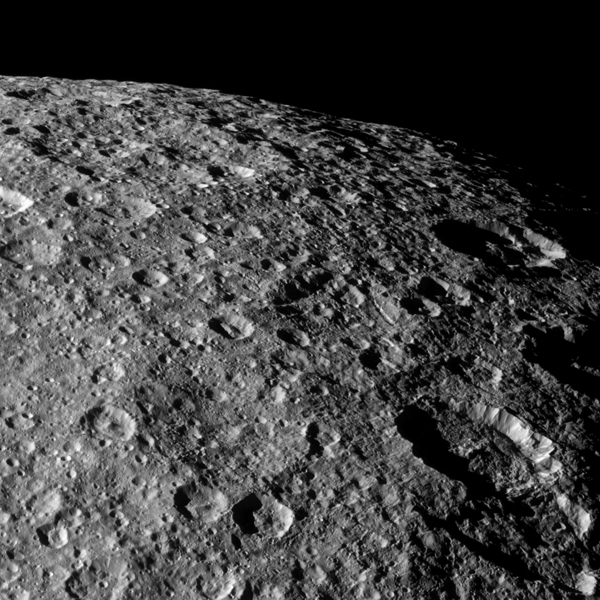“Take a good, long, luxurious look at these sights from another world,” said Cassini Imaging Team Leader Carolyn Porco, “as they will be the last close-ups you’ll ever see of this particular moon.”
On Saturday, March 9, 2013 Cassini made the last close flyby of Rhea during its mission, coming within 620 miles (997km) of the surface of the moon. Cassini’s mission is slated to end in 2017 with a controlled fall into Saturn’s atmosphere. Cassini has been in orbit around Saturn since 2004 and is in its second mission extension.
“Our mission at Saturn has been ongoing for nearly 9 years and is slated to continue for another 4,” Porco said in an email message. “Targeted flybys of the moons Dione, in June and August of 2015, and Enceladus, in October and December of 2015, are all that remains on the docket for detailed exploration of Saturn’s medium-sized moons.”
See more below:

Besides these great final shots, NASA said the primary purpose of this last close flyby of Rhea was to probe the internal structure of the moon by measuring the gravitational pull of Rhea against the spacecraft’s steady radio link to NASA’s Deep Space Network here on Earth. The results will help scientists understand whether the moon is homogeneous all the way through or whether it has differentiated into the layers of core, mantle and crust.
In addition, Cassini’s imaging cameras will take ultraviolet, infrared and visible-light data from Rhea’s surface. The cosmic dust analyzer will try to detect any dusty debris flying off the surface from tiny meteoroid bombardments to further scientists’ understanding of the rate at which “foreign” objects are raining into the Saturn system.
“We’re nearing the end of this historic expedition,” Porco said. “Let’s enjoy the finale while we can.”

See more of the raw images from the flyby at the CICLOPS website.


Seen one moon, seen them all…
😀 nah, these are pretty awesome.
No, every moon is different. Just as there are no two planets alike. Each one has its own exciting story to tell. God is an awesome GOD. All of this Universe, out of chaos? I doubt it.
“they will be the last close-ups you’ll ever see of this particular moon.” Where’s the moon going? Is it about to disappear? Why are these the last? There’s never going to be another mission? That’s a strange statement to make, unless they know something we don’t.
We’re probably going to be dead by the next mission, sadly. Aging is a bitch.
Given that the next mission to Saturn isn’t scheduled to arrive until at *least* 2040 (more likely 2050), these are the last close-up images of this moon many of those reading the press release will ever see.
The US and NASA is not the only country you know.
Many different countries and organisations might decide to launch a probe.
You may find this hard to believe, but I was thinking of proposed ESA missions when speculating on that timeline:). NASA has nothing even that firm planned. They’ve just given up on the everything past Jupiter.
You think very strange thoughts.
Dude, give us a break! How about you geniuses, showing a little common-sense? You should know tha he is referring to the Cassini spacecraft…it is not planned to visit these moons again during its mission.Dam! use your frrrkikking brains.
Very detail pictures. I’ll wait to see something special from you – Porco
The Cassini mission has been a spectacular success in so many ways. These latest images proves the point… and the ‘fat lady’ isn’t done singing! HO!
Cool and awesome pictures.I love ’em.
Reflecting on the breathtaking vistas, spectacular panoramas, and surreal perspectives, that that robotic alien, studying the Saturn System, has returned (in treasure flow of data, and unworldly picture-stream of beauty), you might almost think an artist planned the times and places of command, charted the routes and angles of frame. Compliments to the team that has filled, not only the computer banks of a Science hall, but interior space of a gallery’s walls (with masterfully wrought pictures). And served a role to lift the human spirit above a trouble world, with majesty of the heavens.
The elegant Ringed World will never look the same!
Sad day when a metallic vapor trail flashes in Saturn’s mammoth sky (perhaps to a roll of thunder), and a Spacecraft honoring Giovanni Domenico Cassini is lost. Besides icy moons of night, and over Rings of cold light, for mankind no longer to fly. In Mathematics of numbers and figures, Engineering build and operation, and Astronomy advance and navigation, the French / Italian will be pleased to learn of its heritage in honor of his gifted name.
love it. amazing picture.Cassini. What would the world be like if the land masses were spread out the same way as now – only rotated by an angle of 90 degrees?